Inorganic semiconductor nanocrystals possess unique optoelectronic properties and can form stable colloids. This was made possible by new methodologies for wet chemical synthesis developed during the last three decades. The nanoparticles are capped by organic ligands that control their nucleation and growth. These ligands are beneficial for colloidal stability, but they also act as barriers between nanocrystals when they are processed into solids, and can, for example, disrupt their electronic communication.
Vladimir Lesnyak and colleagues, Technical University Dresden, Germany, sought to replace organic molecules on the surface of the nanocrystals with compact ligands that provide better interparticle contact. They developed a novel approach to form 3D non-ordered superstructures (gels) based on electrostatically stabilized all-inorganic semiconductor nanocrystals with different morphologies, compositions, and sizes, together with inorganic capping ligands.
The team synthesized CdSe, PbS, PbSe, and ZnO semiconductor nanocrystals and replaced their organic capping ligands with different inorganic ligands, e.g., S2−, I−, Cl−, and F−. The then induced gelation of the anion-functionalized nanocrystals by adding Cd2+, Pb2+, and Zn2+ ions, respectively, in the form of their acetate salts.
The electronic structure of the original quantum-confined semiconductor nanocrystals is preserved in the resulting highly porous macroscopic materials. These 3D superstructures may find technological applications in sensors and catalysts.
- 3D Assembly of All-Inorganic Colloidal Nanocrystals into Gels and Aerogels,
Vladimir Sayevich, Bin Cai, Albrecht Benad, Danny Haubold, Luisa Sonntag, Nikolai Gaponik, Vladimir Lesnyak, Alexander Eychmüller,
Angew. Chem. Int. Ed. 2016, 55, 6334–6338.
DOI: 10.1002/anie.201600094




